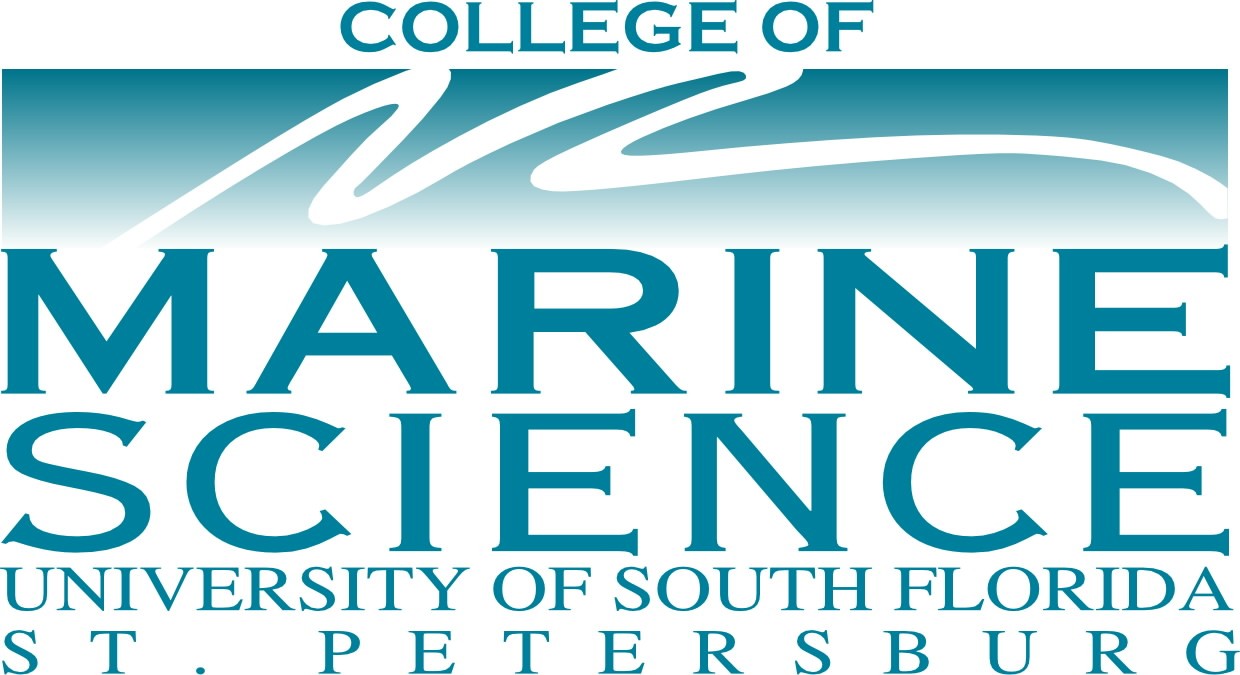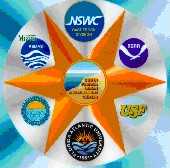
Alexander V. Soloviev
Nova Southeastern University
Oceanographic Center, 8000 North Ocean Dr., Dania Beach, Florida 33004.
Mark E. Luther and Robert
H. Weisberg
Department of Marine Science,
University of South Florida, 140 Seventh Ave S, St. Petersburg, Florida
33701
Introduction
Experimental Design
Observations
Internal
Oscillations on the Shelf off Southeast Florida
Conclusions
Acknowledgements
References
Forum
WBC HOME
![]()
Historical and recent data reveal a very energetic regime on the shelf off the southeast Florida. In addition to what has been known as spin off eddies, large-amplitude tidal velocity fluctuations with amplitudes exceeding 0.5 m/s are observed. The recent exploratory measurements conducted as a part of the South Florida Ocean Measurement Center (SFOMC) show that the time scale of these oscillations is about 10 hrs. This time period doesn’t coincide either with the inertial period (27 Hrs) or with the semidiurnal M2 (12.42 hrs) or S2 (12 hrs) tidal constituents. In addition, these internal oscillations appear to be modulated seasonally and over time scales of 10 days or so. The hypothesis we are discussing in this virtual poster is that these oscillations are actually near-resonant internal seiches generated by barotropic tidal wave in the channel between Florida and Bahamas.
One of the first documented observations of large-amplitude tidal velocity fluctuations in the Florida Straits goes back to the works of J. E. Pillsbury in the late years of the 19th century. He found that approximately twice a day the surface velocity changes for as much as 1 knot (0.5 ms-1) in some regions of the Florida Straits. Similar velocity fluctuations were measured by Parr (1937) and Richardson and Schmitz (1967) with current meters and free-falling profilers. Some other investigators (e.g., Smith et al. 1969), however, did not observe such strong velocity oscillations in the Florida Straits. The recent long-term observations on the shelf off Southeast Florida as a part of SFOMC show that these internal oscillations are of about 10-hr period and seasonally modulated; they are observed primarily during summer months. It happened that the experiment of Smith et al. (1969) took place in the fall and winter seasons when the 10 hr on the velocity spectrum does not appear to be prominent.
In his book The Gulf Stream, Stommel (1965) suggested that it is highly probable that an internal resonant seiche accounts for the semi-diurnal tidal velocity fluctuations in the Florida Current. Niiler (1968) proposed a model demonstrating that cross-channel baroclinic tidal oscillation could be excited by a tidal surface wave traveling along the non-uniform channel. The baroclinic oscillation becomes large if the period of the surface wave is close to the natural period of an internal seiche in the channel. (Note that in the SFOMC range this period is close to 10 hrs.) The instrumentation capabilities in 1960s’, however, were ill matched to the job of making definitive statements about the governing physics in such a region of complex motions as the Florida Straits. Though adequate observational techniques emerged in 1980s-1990s, the main interests of oceanographers had shifted to the open ocean regions.
The new stage of studying the Florida Current begins in 1998 with establishing the South Florida Ocean Measurement Center. As a part of SFOMC, a three-dimensional mooring array was deployed, with acoustic Doppler current profilers (ADCP) and a combination of recording temperature and salinity sensors on each mooring. These measurements are carried out since July 1999 and are a cooperative experiment between the University of South Florida and Nova Southeastern University.
The experiment is designed to support SFOMC field tests of Autonomous Underwater Vehicles and to collect a complete seasonal cycle for describing western boundary current/continental shelf interactions, including extreme conditions during hurricanes. In addition, the array provides data useful for understanding a variety of scientific questions. These questions include: What are the dominant modes of interaction between the nearby Gulf Stream and the shelf/near shore circulation? Are these events driven by the wind, Gulf Stream Meanders, propagating continental shelf waves, or near-shore eddies? What is the structure and temporal variability of the internal wave field within the SFOMC Range?
The SFOMC Environmental Array, deployment schemes, and data acquisition software are developed at the USF College of Marine Science and the NSU Oceanographic Center. The design of the array meets two objectives: It satisfies the monitoring needs of the other experiments on the SFOMC range; it also is able to provide data that can answer scientific questions like those posed above.
The Environmental Array, including one
bottom mooring (NW) and two surface moorings (NE and SW), was deployed
at the SFOMC range in June-July 1999. The Environmental Array has provided
data during the 4 Dimensional and Adverse Weather Experiment in 1999 and
2000. The configuration of the mooring array during the SFOMC 1999 Experiment
is shown in Figure 1. Some changes to this design were made for the SFOMC
2000 Experiment to adjust the array and our schedule to the modified plans
of our SFOMC partners.

The NW bottom mooring consists of a concrete anchor, a SBE-26 Wave and Tide Recorder, and an upward looking RDI Workhorse Sentinel 300 kHz ADCP. The NE and SW surface moorings mechanical construction consists of a surface buoy, three segments of chain, wire rope, and an anchor. A downward-looking WH Sentinel 600kHz ADCP measures the vertical profile of horizontal velocity. A chain of inductively coupled SBE-37 MicroCats provides detailed information on the temperature (T), salinity (S), and density (st) fields. There is a Weather Pack (Coastal Climate, Inc.) on the NE mooring, providing measurements of wind speed and direction, air temperature, humidity, atmospheric pressure, and precipitation.
The NW bottom and the NE and SW surface moorings were deployed on 11-m (26o04.23’N, 80o05.65’W), 50-m (26o04.170’N, 80o04.610’W), and 20-m (19o49.413’N, 71o48.094’W ) isobaths respectively (Fig. 1). In addition, a 3-MicroCat chain of instruments was installed on the SE mooring in December 1999 and recovered in January 2000 as a part of the University of Miami (UM) acoustic experiment.
The NW bottom array has been operating in a self-recording mode (pending cable connection to the shore). The surface moorings (except of the SE mooring) transmit data in real time via the radio channels line-of-sight spread-spectrum radio and stored on a data acquisition computer at the NSU Oceanographic Center. The data are stored in the NSU computers, USF network, and internally on the moorings. The data acquisition system is developed to interface with the WH Sentinel ADCP, Coastal Climate Weather-pack, and a Seabird Electronics Inductive Modem (IM). Communication to these instruments is via a 900 MHz FreeWave radio modem. The software is based on a PC running the Red Hat LINUX operating system. Separate programs are developed to acquire data from each of the instruments. The computers are connected to the Internet, which provides real time remote access to the system.
Figure 2 shows an example of the velocity and density variability observed at a 50-m isobath (NE mooring) in July 1999. The velocity contour plot reveals the +/-1 knot velocity oscillations that are accompanied by the density variations. This is an indication that the observed velocity oscillations are of baroclinic nature.
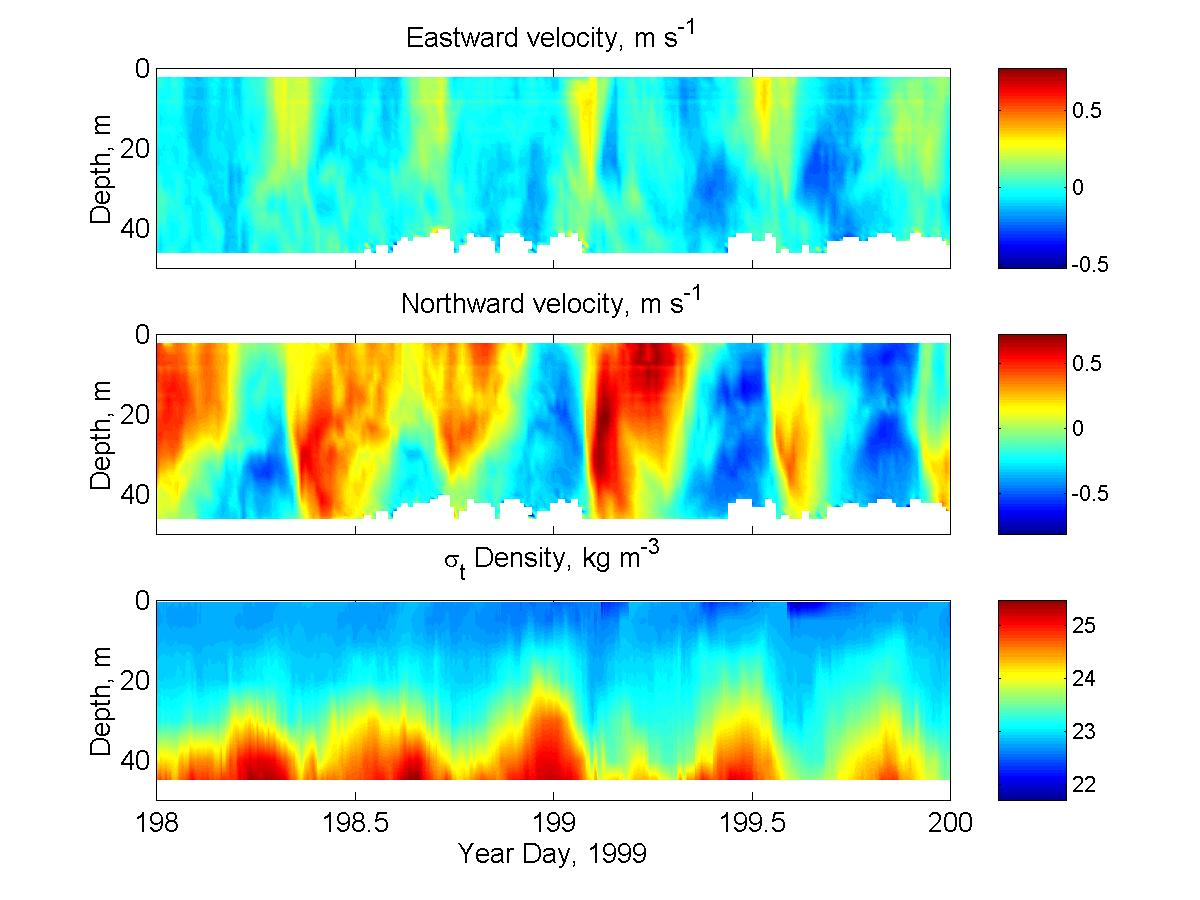
Fig. 2. Internal oscillations with ~10-hr period observed in the velocity
and density fields on the shelf off southeast Florida in July 1999 (NE
Mooring, 50-m isobath).
The time period of the dominating oscillation in Figure 2 is about 10 hrs. Spectral analysis of the velocity signal (made on a two-week record including the time period shown in Figure 2) does reveal a peak on the frequency corresponding to a 10-hr time period (Fig. 3b). A peak at the 10 hr period is also observed on the respective density spectrum (not shown here). Spectral analysis of the simultaneous velocity records from the SW surface mooring and NW bottom mount also shows a pronounced peak at a 10-hr time period (Fig. 3b).

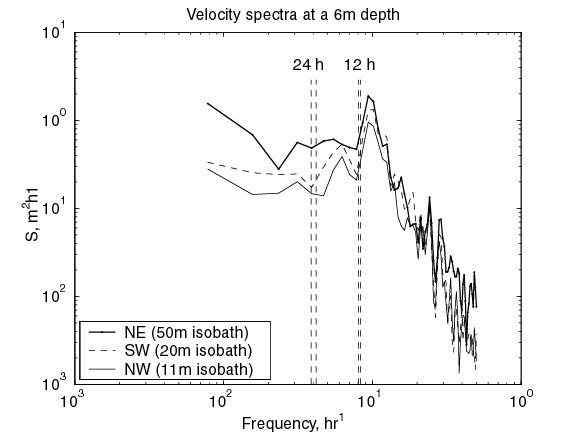
Fig. 3. (a) Sealevel (upper panel) and (b) velocity (lower panel) spectra in the SFOMC range according to measurements in July 1999. Note a 2- hr “blue” shift of the tidal peak in the velocity spectra compare to the sea-level spectrum. The tidal constituents near 24 hrs (O1 and K1) and near 12 hrs (M2 and S2) are marked by vertical dashes.
Strong periodicity of the velocity and density variations in Figure 2 suggests that this oscillation is excited either by inertial or tidal forces. The inertial period at the latitude of the SFOMC range (27 hrs), however, is substantially different from the 10 hr period of the observed velocity oscillation. According to the U.S. Coast and Geodetic Survey in Washington DC, the semidiurnal tidal constituents in the Florida Straits are M2 (12.42 hrs) and S2 (12 hrs). The sealevel gauge mounted on the NW mooring shows a semi-diurnal surface tide (barotropic wave) of about 40 cm amplitude. The spectral analysis of the sealevel signal reveals a semidiurnal tidal peak close to the 12 hr time period (Fig. 3a). The corresponding peak, however, cannot be clearly seen on the velocity spectrum (Fig. 3b) (instead, a 10-hr peak is prominent).
This paradox can be resolved if we will recall that the sealevel variations are mainly related to the barotropic motions, while the current velocities depend both on barotropic and baroclinic processes. The contribution of the barotropic component on the velocity signal is estimated in Figure 4b. This figure compares the velocity spectra in summer and winter with the corresponding velocity spectra calculated from the sea level records using the long wave gravity theory (LeBlond and Mysak, 1978). (Note that this theory does not work in the vicinity of the inertial period, which is equal to about 27 hours on the latitude of the SFOMC range.) According to Figure 4b, the barotropic signal is weak in the velocity signal, especially during summer. This is consistent with the strong baroclinicity of the Florida Current.
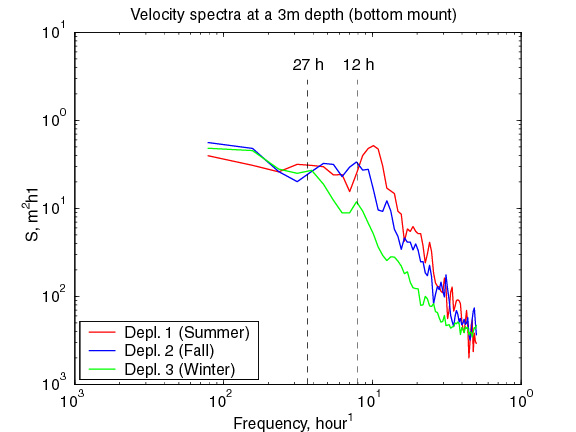
Fig. 4a. Seasonal variability of the velocity spectra in the SFOMC range. The inertial (27 hrs) and semidiurnal (12 hrs) tidal periods are shown by vertical dashes.
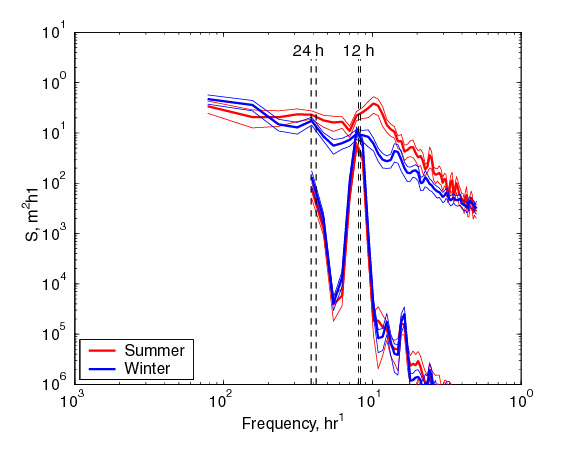
Fig 4b. The velocity spectra (two upper bold curves) are compared to the spectra of barotropic tidal velocities (two lower bold curves) calculated from the sea level spectrum. Thin lines are 95% confidence limits. Detail tidal constituents near 24 hrs (O1 and K1) and near 12 hrs (M2 and S2) are marked by vertical dashes.
Analysis of the long-term velocity records obtained during the first two years of the SFOMC experiments allows us to reveal seasonal dependence of the velocity spectra (Fig. 4a). These spectra are calculated from several-months long record segments. According to Figure 4a, the large amplitude velocity fluctuations with a 10-hr time period are primarily observed during summer months. During the fall and winter seasons, the 10 hr period oscillation is not prominent. The 10 hr velocity oscillation is also modulated over time scales of about 10 days or less, which is perhaps a result of their interaction with the spin off eddies that are observed on the shelf off southeast Florida (e.g., Lee and Mayer, 1977; Shay et al., 2000).
Internal Oscillations on the Shelf off Southeast Florida
The data from the SFOMC project thus clearly demonstrates that there is a strong baroclinic velocity signal on the shelf off the Southeast Florida. In fact, the baroclinic component dominates the coastal circulation during summer months. The closeness of the velocity oscillation time period, 10 hrs, to the semidiurnal tidal constituents, M2 (12.42 hrs) and S2 (12 hrs), as well as the presence of the pronounced peak on both density and velocity spectra, suggest that this is the type of motion excited by tidal rather than inertial forces.
The surface (barotropic) tidal waves travel south through the Florida Straits (from North Atlantic to the Gulf of Mexico) at a speed of about 80 m s-1. The maximum current oscillations associated with barotropic tidal waves are, however, only of about several cm s-1. As it has been demonstrated in Figure 4b, the barotropic component is not prominent in the velocity signal.
The cross-channel baroclinic tidal oscillation could be excited by a tidal surface wave traveling along the non-uniform channel (Niiler, 1968). In this theory, an abrupt change of the channel depth at the edge of continental shelf is a critical factor in the exchange of energy between the surface and internal wave. Another critical factor determining the resonant properties of the channel is the vertical density stratification (as well as the position of the stratified layer with respect to the continental shelf break). The baroclinic oscillation becomes large if the period of the surface wave is close to the natural period of an internal seiche in the channel. The baroclinic seiche dominates in the velocity field, while the barotropic component determines the sealevel variations.
The natural period of an internal seiche in the Florida Straits at the SFOMC range during summer time is about 10 hrs. The peak on the velocity spectra (Fig. 3b) is observed near a 10-hr time period; this is an argument in favor of the internal seiche hypothesis. The seasonal modulation of the velocity fluctuations can be explained by the dependence of the “resonant” properties of the Florida Straits on stratification and position of Gulf Stream. The modulation over time scales of about 10 days or less is probably the result of an interaction between the internal seiche and the spin off eddies that are observed on the shelf off southeast Florida (e.g., Lee and Mayer, 1977; Wunsh and Wimbush 1977; Shay et al., 2000).
The internal seiche theory predicts that large tidal velocity oscillations on the shelf also develop in the cold fluid layer and are accompanied by reversals of the Gulf Stream velocity near the bottom. It is remarkable that such current reversals are found on the example shown in Figure 2.
The coastal circulation on the shelf off Southeast Florida is strongly related to the dynamics of the Florida Current. A strong highly baroclinic current is confined to flow over a rapidly changing 3-dimensional topography. Superimposed upon the mean Florida Current are a great variety of motions spanning a large range of time and space scales, possessing both spatial inhomogeneities related to the topography, mean current structure, river discharges (at some extent), and temporal inhomogeneities evidently related to the local meteorological conditions.
The recent SFOMC data set covering a 2-year time period (1999-2001) clearly demonstrates that the characteristic feature of the coastal circulation on the shelf off southeast Florida is a very strong baroclinic velocity fluctuation (sometimes exceeding 0.5 m/s) with a 10-hr time period. This high-energy fluctuation is modulated seasonally as well as on a shorter time scale. The data appears to be consistent at least in the general features with the Stommell’s hypothesis of a resonant cross-stream semidiurnal internal seiche in the channel between Florida and Bahamas. The modulation on the seasonal time scale can be explained by the dependence of the channel resonant properties on the stratification and position of Gulf Stream. The stratification is also affected by the spin off eddies, which may be another factor in the modulation of the 10-hr velocity oscillation on shorter time scales.
A more detailed study of this phenomenon is important for modeling and prediction of the coastal circulation on the shelf off southeast Florida (which is an area of most rapidly growing population in the US). The large amplitude super-tidal baroclinic oscillations apparently affect the navigation and acoustics in the area. The cross-shelf exchange of the pollutants and biological spices also depends on this high-energy oscillation.
We gratefully acknowledge Prof. J.P. McCreary (NSU and UH) for his intellectual input into organization of this project. Our colleagues, Rick Cole, Jeff Donovan, and David Burwell (USF), Terry Thompson, and Laszlo Nemeth (NSU), provided excellent technical support during the project. Special thanks go to Doug Briggs and Bob Franks (FAU), Dave Gilliam, Brian Ettinger, and Lance Robinson (NSU). SFTF personnel were also very helpful with the mooring operations. We thank Michael Crane (NOAA) and Courtney Campbell (NSU) for their help in preparation of the database and our partners from FAU and UM for fruitful discussions of the SFOMC results. The ONR support of this project via a subcontract to FAU is acknowledged.
LeBlond, P.H., and L.A. Mysak, Waves in the Ocean, Elsevier, 602 pp, 1978.
Lee, T. N. and D.A. Mayer, Low-frequency current variability and spin-off eddies along the shelf off Southeast Florida. Journal of Marine Research, 35, 193-220, 1977.
McCreary, J., A. Soloviev, R. Weisberg, and M. Luther, Environmental array and data analysis (SFOMS Report 5), ONR Ocean, Atmosphere, and Space S&T Department Annual Report, FY2000, Office of Naval Research, 2000.
Niiler, P.N., On the internal tidal motion in the Florida Straits, Deep-Sea Research, 15, 113-123, 1968.
Parr, A.E., Report on hydrographic observations at a series of anchor stations across the Straits of Florida. Bull. Bingham Oceanogr. Coll., 6(3), 1-63, 1937.
Schmitz, W.J., and W.S.Richardson, On the transport of the Florida Current, Deep-Sea Research, 15, 679-693, 1968.
Shay, L. K., T. M. Cook, B. K. Haus, J. Martinez, H. Peters, J. VanLeer, A. J. Mariano, P. E. An, S. Smith, A. Soloviev, R. Weisberg, and M. Luther, 2000: VHF Radar detects submesoscale vortex along the Florida Coast, EOS, 81, 209-213, 2000.
Smith, J.A., B.A. Zetler, and S. Broida, Tidal modulation of the Florida Current surface flow, Mar. Tech. Soc. Jr, 3(3), 41-46, 1969.
Stommel, H., The Gulf Stream—a physical and dynamical description, p. 68, University of California Press, Berkley, 1965, 248 pp.
Wunsh, C. and M. Wimbush, Simultaneous
pressure, velocity, and temperature measurements in the Florida Straits,
Journal of Marine Research, 35, 75-104,1977.
![]()
Copyright © 2001


